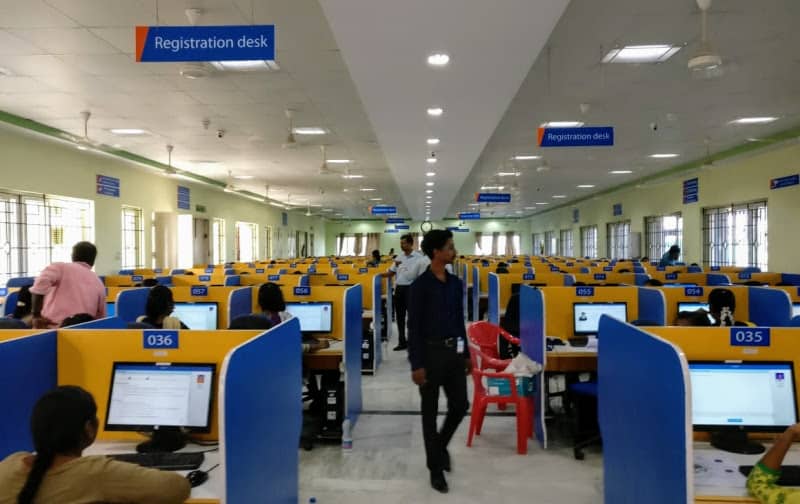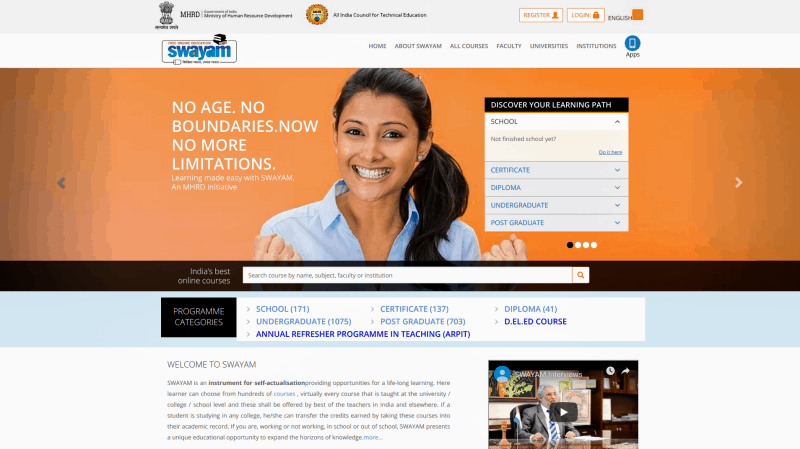In India, MOOCs Are Now Part of the Education System
Students in India public higher education may complete part of their degree online by taking courses on SWAYAM, India’s national MOOC platform.

SWAYAM exams underway — tweeted by R. Subrahmanyam, India’s Education Secretary
In December 2018, 3,800 students flocked to exam centers across India to sit exams for courses taken on SWAYAM, India’s national MOOC platform. It was the first time SWAYAM exams were organized. And what made these special is that, although SWAYAM courses are offered online, they can lead to actual academic credit.
Origins
SWAYAM — that stands for Study Webs of Active-Learning for Young Aspiring Minds and means self in Hindi — is an online course provider first announced by the Government of India in August 2014, beta launched in August 2016, and fully launched in July 2017.
The platform is part of the Digital India initiative to empower the nation and its citizens through technology. Specifically, the platform goals are to facilitate access to quality education, support lifelong learning, and increase enrollments in India’s higher education.
On SWAYAM’s launch, Pranab Mukherjee, then President of India, stated: “internet has offered an opportunity to quell the divide in terms of access and quality […] digital modes are cheaper, more easily accessible, interactive, and offer flexibility […] We need to work together to ensure that they are widely adopted for teaching.”
Platform
With a catalog of 2,000 courses, SWAYAM is one of the world’s largest MOOC providers. The courses are taught by 1,250 instructors affiliated with 130 institutions, including:
- Central universities, such as Delhi University.
- State universities, such as Jadavpur University.
- Autonomous institutes, such as IIT Bombay.
Growth is incentivized by compensating faculty and staff for creating and running courses. For instance, according to the remuneration model issued by India’s Ministry of Human Resource Development, instructors are paid about $150 per hour spent teaching on camera.
To date, India has invested more than $33 million in SWAYAM. But despite this cost, the platform is open — SWAYAM courses are free to take.
(For more details about the platform and its origins, head to our previous articles. Class Central has been following SWAYAM’s development since it was announced back in 2014.)
Academic Credit
But SWAYAM’s most distinctive feature isn’t its scale or openness, but rather its integration into India’s education system. Indeed, public higher education institutions in India may allow their students to complete up to 20% of their degree online by taking courses on SWAYAM.
SWAYAM’s credit system is laid out in the framework issued by the University Grants Commission, the organisation that oversees India’s higher education.
Twice a year, institutions pick SWAYAM courses they’ll grant credit for in the upcoming term. Note that they may pick courses offered by other institutions, allowing them to tap into the strengths of schools nationwide to build richer curricula. For instance, they may leverage SWAYAM to offer high-demand courses for which they lack qualified instructors on campus.
Students may then register for relevant, credit-eligible online courses and, upon completion, have them count toward their degree. Courses typically involve watching lectures, submitting assignments, and sitting an exam in one of the 1,000 exam centers established across India.
First @SWAYAMMHRD pen and paper examination for 39 ,@ugc_india swayam courses successfully conducted today at 50 centres all over India. Congratulations to UGC, Swayam and Mhrd teams and Best of Luck to the candidates appearing for swayam exam. pic.twitter.com/xwM8i6cTbb
— Dr (Mrs) Pankaj Mittal (@pankajugc) January 19, 2019
Registering for an exam may cost up to $15. But that fee is usually refunded if the student passes the exam.
Significance
As an emerging superpower that accounts for almost one fifth of the world’s population, India’s bet on MOOCs sends a strong message: integrating online and traditional education can help developing nations overcome challenges, such as:
- Enrollment Drops: Thanks to SWAYAM, India hopes to raise national enrollments in higher education to 30% by 2021.
- Faculty Shortages: By leveraging SWAYAM, schools can expand their course catalog without having to rely on local instructors.
- Geographical Barriers: Through satellite internet, SWAYAM allows schools to extend their reach beyond their local area and into rural India.
And some developing nations have already taken heed of this message. In late 2018, India and Afghanistan signed a cooperation agreement to let Afghanistan institutions and students respectively offer and take courses on SWAYAM.
But beyond the developing world, integrating online and traditional education may also help developed nations seize opportunities, including:
- Lowering Costs: By making reusable, shareable, and scalable online courses part of the education system, MOOCs can make a dent in the costs of higher education.
- Increasing Flexibility: By allowing learners to study when and where is more convenient to them, MOOCs are more likely to attract working professionals.
- Facilitating Credit Mobility: By encouraging institutions to contribute to a collective pool of credit-eligible courses, MOOCs can help streamline credit transfer.
And these opportunities resonate with the goals of leading actors in the MOOC world. In a talk titled Reimagine Education, Anant Agarwal, edX CEO and MIT professor, challenges institutions to “accept 25% of the credit” earned by a student at another institution.
SWAYAM shows one way toward that goal.
Tags








Ajay
What about the quality of these courses? Indian education system does not have a good reputation of offering quality courses. From what I hear students and faculties in engineering institutions across India are being forced to enroll into these courses. Most of them are not keen on gaining knowledge but in getting certificates.
Soren
Good point. Quality is often left a side when talking about MOOC. Focus is on acces and the potential of edcation the many. The stragtegy is good, thinkingof educations people- but itmight seem more as an image stunt by the government to bring good stories which will attract money
Krishna
Courses are extremely well designed. Content is good. The instructors are of good reputation. No need to spin stories instead let us spend time to study, take test, qualify and take this message to a larger audience.
I run an international education venture since 2011 and personally finding the course on Yoga offered by Sridhar Melukote as one of the best. Which course did you enroll, study and get certified to comment?
Eric Hrahsel
I really hope i can complete my M.A in swayam.
Mahendra Acharya
Very good initiative for spreading education and learning for everybody at anywhere. SWAYAM can co-ordinate with other world famous MOOC providers like, Coursera, MIT, Open University, Khan Academy, Edux, University Of The People. and others and deliver their courses in India. The most of these. Courses are offered by welknown universities and mostly they are free, or with little fees.
swagman
The quality of the MOOCs in SWAYAM and NPTEL are absolutely crap. It’s cheap (no scripts or nothing), teachers teach without enthusiasm, the TAs don’t solve your doubts. It’s a hellhole. I mean check out the quality of the courses on Coursera or Udacity, they are filmed with a production value in mind. Make the courses like you are writing a goddamn film. Damn you SWAYAM.
Dr Jai R C
Please let me know the fee structures of MBA through MOOC various universities.
Dr. Enoch
Can a person (not working in any institution but with higher eligibility) create content for online swayam courses?